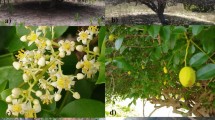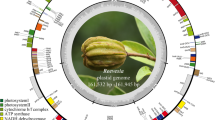Abstract
Using the isozyme analysis, genetic variations in six species of the genus Oxytropis DC. (Fabaceae) from Kamchatka was assessed. It was demonstrated that diploid species from the section Arctobia were characterized by a low level of variations typical of endemic plant species. At the same time, polyploid species from the Orobia section demonstrated very high values of the heterozygosity parameters (H o varied from 0.200 to 0.274). It has been suggested that the level of polymorphism of the oxytropes from Kamchatka was shaped as a result of the interaction of a number of factors, among which the most important are the ecological confinedness of the species, the specific features of the reproductive system, and gene drift. In the species of Orobia section, it is also the presence of the polyploid genome.
Similar content being viewed by others
References
Man’ko, Yu.I. and Sidel’nikov, A.N., Vliyanie vulkanizma na rastitel’nost’ (The Influence of Volcanism upon the Vegetation), Vladivostok: Dal’nevost. Otd. Akad. Nauk SSSR, 1989.
Voronkova, N.M., Kholina, A.B., and Verkholat, V.P., Plant biomorphology and seed germination in pioneer species of Kamchatka volcanoes, Biol. Bull., 2008, vol. 35, no. 6, pp. 599–605.
Dolezal, J., Homma, K., Vyatkina, M.P., et al., Primary succession following deglaciation at Koryto glacier valley, Kamchatka, Arct. Antarct. Alp. Res., 2008, vol. 40, no. 2, pp. 309–322.
Voronkova, N.M., Verkholat, V.P., and Kholina, A.B., Specific features of plants at early stages of the colonization of loose volcanic matter, Biol. Bull., 2011, vol. 38, no. 3, pp. 237–241.
Yakubov, V.V. and Chernyagina, O.A., Katalog flory Kamchatki (sosudistye rasteniya) (Catalog of Flora of Kamchatka (Vascular Plants)), Petropavlovsk-Kamchatskii: Kamchatpress, 2004.
Yurtsev, B.A., Oxytropis DC., in Arkticheskaya flora SSSR (Arctic Flora of the Soviet Union), Yurtsev, B.A., Ed., Leningrad: Nauka, 1986, no. 9, part 2, pp. 61–146.
Pavlova, N.S., Legumes—Fabaceae, in Sosudistye rasteniya sovetskogo Dal’nego Vostoka (Vascular Plants of the Soviet Far East), Kharkevich, S.S., Ed., Leningrad: Nauka, 1989, vol. 4, pp. 191–339.
Vlasova, N.V., Dyukhina, E.I., and Trubina, L.K., Patterns of geographical distribution of the section Arctobia genus Oxytropis (Fabaceae), in Rastitel’nyi mir Aziatskoi Rossii (Vegetation World of Asiatic Russia), 2008, no. 1, pp. 10–16.
Yakubov, V.V., Endemic species of flora of Kamchatka, in Sokhranenie bioraznoobraziya Kamchatki i prilegayushchikh morei (Conservation of Biodiversity of Kamchatka and Adjacent Seas), (Proc. 5th Sci. Conf.), Tokranov., A.M., Ed., Petropavlovsk-Kamchatskii, 2004, pp. 112–115.
Krasnaya kniga Yakutskoi ASSR: Redkie i nakhodyashchiesya pod ugrozoi ischeznoveniya vidy rastenii (Red Book of Yakut ASSR: Rare and Endangered Plant Species), Novosibirsk: Nauka, 1987.
Kholina, A.B., Koren, O.G., and Zhuravlev, Yu.N., Allozyme variation in Oxytropis retusa Matsum. from the Kuril Archipelago, Nat. Hist. Res. Chiba. Spec. Issue, 2000, no. 7, pp. 15–20.
Kholina, A.B., Koren, O.G., and Zhuravlev, Yu.N., Genetic structure and differentiation of populations of the tetraploid species Oxytropis chankaensis (Fabaceae), Russ. J. Genet., 2009, vol. 45, no. 1, pp. 70–80.
Artyukova, E.V., Kozyrenko, M.M., Kholina, A.B., and Zhuravlev, Yu.N., High chloroplast haplotype diversity in the endemic legume Oxytropis chankaensis may result from independent polyploidization events, Genetics, 2011, vol. 139, no. 2, pp. 221–232.
Kholina, A.B. and Nakonechnaya, O.V., Allozyme polymorphism in six Oxytropis species from Siberia and the Far East, in Sovremennye issledovaniya v biologii (Modern Research in Biology), (Proc. 1st All-Russian Conf.), Vladivostok, 2012, pp. 281–285.
Probatova, N.S., Rudyka, E.G., Seledets, V.P., and Nechaev, V.A., Oxytropis kamtschatica, Oxytropis ochotensis, Oxytropis revoluta in IAPT/IOPB Chromosome Data 6, Marhold, K., Ed., Taxon, 2008, vol. 57, no. 4, p. 1270.
Probatova, N.S., Seledets, V.P., Gnutikov, A.A., and Shatokhina, A.V., Oxytropis erecta, Oxytropis exserta, in IAPT/IOPB Chromosome Data 6, Marhold, K., Ed., Taxon, 2008, vol. 57, no. 4, p. 1272.
Probatova, N.S., Kazanovsky, S.G., Rudyka, E.G., et al., Oxytropis evenorum, in IAPT/IOPB Chromosome Data 6, Marhold, K., Ed., Taxon, 2011, vol. 60,no. 6, p. 1792.
Goncharenko, G.G., Padutov, V.E., and Potenko, V.V., Rukovodstvo po issledovaniyu khvoinykh vidov metodom elektroforeticheskogo analiza izofermentov (Guide to Conifer Species Research by Isozyme Electrophoretic Methods), Gomel’: Polespechat’, 1989.
Zhivotovskii, L.A., Populyatsionnaya biometriya (Population Biometry), Moscow: Nauka, 1991.
Nei, M., Genetic distance between populations, Am. Nat., 1972, vol. 106, no. 949, pp. 283–292.
Ota, T., DISPAN: Genetic Distance and Phylogenetic Analysis, Pennsylvania State Univ., 1993. http://www.bio.psu.edu/People/Faculty/Nei/Lab/dis-pan2.htm
Hamrick, J.L. and Godt, M.J.W., Effects of life history traits on genetic diversity in plant species, Phil. Trans. R. Soc. Lond. B, 1996, vol. 351, pp. 1291–1298.
Dinamika populyatsionnykh genofondov pri antropogennykh vozdeistviyakh (Dynamics of Population Gene Pools under Anthropogenic Impact), Altukhov, Yu.P., Ed., Moscow: Nauka, 2004.
Soltis, P.S. and Soltis, D.E., The role of genetic and genomic attributes in the success of polyploids, Proc. Natl. Acad. Sci. U.S.A., 2000, vol. 97, pp. 7051–7057.
Lopez-Pijol, J., Bosch, M., Simon, J., and Blanche, S., Allozyme diversity in the tetraploid endemic Thymus loscosii (Lamiaceae), Ann. Bot., 2004, vol. 93, pp. 323–332.
Vucetich, J.A. and Waite, T.A., Spatial patterns of demography and genetic processes across the species’ range: Null hypotheses for landscape conservation genetics, Conserv. Genet., 2003, vol. 4, pp. 639–645.
Shurkhal, A.V., Podogas, A.V., and Zhivotovskii, L.A., Levels of genetic differentiation in the hard pines, subgenus Pinus, genus Pinus, from data on allozyme variation, Genetika (Moscow), 1993, vol. 29, no. 1, pp. 77–90.
Jorgensen, J.L., Stehlik, I., Brochmann, C., and Conti, E., Implication of its sequences and RAPD markers for the taxonomy and biogeography of the Oxytropis campestris and O. arctica (Fabaceae) complexes in Alaska, Am. J. Bot., 2003, vol. 90, no. 10, pp. 1470–1480.
Chung, M., Gelembiuk, G., and Givnish, T.J., Population genetics and phylogeography of endangered Oxytropis campestris var. chartacea and relatives: Arcticalpine disjuncts in eastern North America, Mol. Ecol., 2004, vol. 13, pp. 3657–3673.
Schonswetter, P., Tribsch, A., and Niklfeld, H., Amplified fragment length polymorphism (AFLP) reveal no genetic divergence of the Eastern Alpine endemic Oxytropis campestris subsp. tirolensis (Fabaceae) from wide-spread subsp. campestris, Plant Syst. Evol., 2004, vol. 244, pp. 245–255.
Archambault, A. and Stromvik, M.V., Evolutionary relationships in Oxytropis species, as estimated from the nuclear ribosomal internal transcribed spacer (ITS) sequences point to multiple expansions into the Arctic, Botany, 2012, vol. 90, no. 8, pp. 770–779.
Artyukova, E.V. and Kozyrenko, M.M., Phylogenetic relationships of Oxytropis chankaensis Jurtz. and Oxytropis oxyphylla (Pall.) DC. (Fabaceae) inferred from the data of sequencing of the ITS region of the nuclear ribosomal DNA operon and intergenic spacers of the chloroplast genome, Russ. J. Genet., 2012, vol. 48, no. 2, pp. 186–193.
Author information
Authors and Affiliations
Corresponding author
Additional information
Original Russian Text © A.B. Kholina, O.V. Nakonechnaya, V.V. Yakubov, O.G. Koren, 2013, published in Genetika, 2013, Vol. 49, No. 10, pp. 1174–1182.
Rights and permissions
About this article
Cite this article
Kholina, A.B., Nakonechnaya, O.V., Yakubov, V.V. et al. Genetic variation in six species of the genus Oxytropis DC. (Fabaceae) from Kamchatka Peninsula. Russ J Genet 49, 1021–1029 (2013). https://doi.org/10.1134/S1022795413100049
Received:
Accepted:
Published:
Issue Date:
DOI: https://doi.org/10.1134/S1022795413100049




